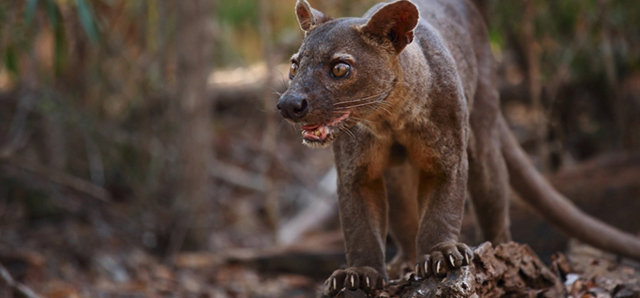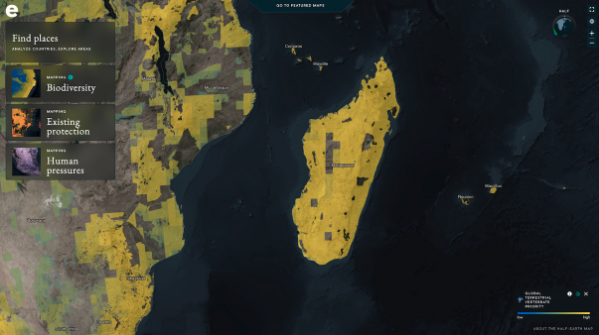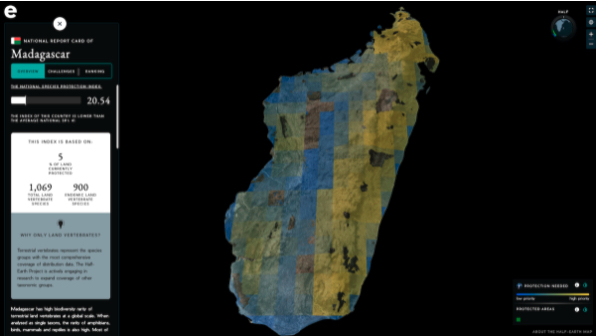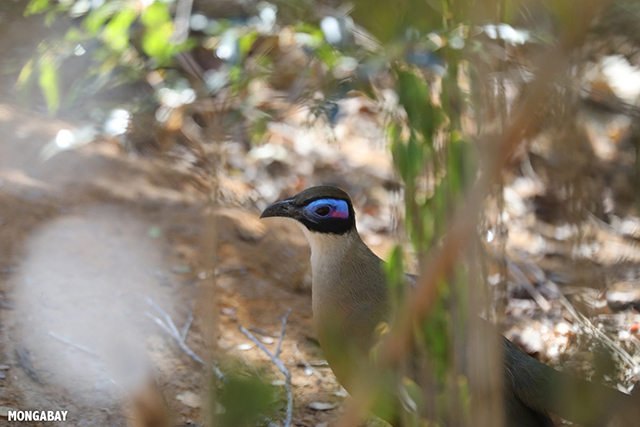

> Last year, the Half-Earth Project launched its “national report cards,” which show how much land is currently protected in each country, how many land vertebrate species (including endemics) each country holds, and how much and also which areas of land should be preserved to protect its biodiversity in the future.
> Each country also receives a score based on several indicators, including the National Species Protection Index (SPI), which was generated by the Map of Life and endorsed by the Convention on Biological Diversity.
> The team at the Half-Earth Project say the map and accompanying tools can be valuable resources for decision-makers trying to reach the objective of protecting 30% of land by 2030, although they argue that the ultimate goal should be protecting half of the Earth.
> While supporters of the Half-Earth Project say achieving their goal benefits everyone, critics say a large number of people, particularly those living in poorer countries, could be adversely affected by such large-scale area-based protection.
As the world grapples with unparalleled rates of deforestation and extinction, an increasing number of governments and other entities are recognizing the importance of protecting 30% of the land and oceans by 2030. In fact, this goal is listed as a target in the first draft of the post-2020 global biodiversity framework published in July.
But is protecting 30% enough?
No, says quantitative ecologist Scott Rinnan of the E.O. Wilson Biodiversity Foundation’s Half-Earth Project. The ultimate goal, according to him, would be to preserve half of the Earth, which he says would be a sufficient area capable of preserving global biodiversity. However, he added that protecting 30% is a “worthwhile objective that we support on the way to half” and that the Half-Earth Project is able to help nations adopt a “coordinated approach to identifying the targets with positive outcomes for global biodiversity.”
The concept of protecting half of the world stems from E.O. Wilson’s Half-Earth:Our Planet’s Fight For Life, a 2016 book that argues that protecting at least half of the planet would help preserve 80% of species and places the Earth in a “safe zone.” The Half-Earth Project provides an array of resources to help make this ambitious goal a reality, the backbone of which is the Half-Earth Project Map, developed by the Map of Life Project at Yale University’s Center for Biodiversity and Global Change; the E.O. Wilson Biodiversity Foundation; science and technology company Vizzuality; and geographic information system company Esri.


One of the Half-Earth Project’s more recent developments, launched last year, is the implementation of “national report cards” into its mapping system, which Rinnan told Mongabay can help answer a complicated but persistent question: Which half do we protect? The report cards provide a snapshot of how much land is currently protected in each country, how many land vertebrate species (including endemic species) each country holds, and how much and also which areas of land should be preserved to protect its biodiversity in the future. In true school-grade style, each country is then given a score to show how well it’s doing using several indicators, including the National Species Protection Index (SPI), which was generated by the Map of Life and endorsed by the Convention on Biological Diversity.
There is also a map of each country with a sliding color scale: the yellow areas denote places most in need of conservation protection, while purple areas are locations of lower priority. Areas in green are those that are already being protected.
Rinnan says the maps tend to prioritize “pristine landscapes” rather than areas that have been heavily modified by humans, since the former might be “doing a better job of sustaining species” and the latter would require “a lot more restoration work.” However, he says there are many instances in which human-modified land will still need to be restored to protect the highest number of species.
Walter Jetz, scientific chair of the E.O. Wilson Biodiversity Foundation, says the Half-Earth Project Map focuses on the protection of biodiversity, since a deterioration in biodiversity has a direct impact on human health and well-being.
“Losing species is bad news in the short term and it could be incredibly problematic in the long term,” Jetz told Mongabay in an interview. “With deteriorating health of biodiversity, we lose important functions: control of pests and agriculture, control of diseases, compounds that may be vital [as] cures against diseases in humans.”
Countries with some of the highest levels of biodiversity are shown to be most in need of further protection. Take Madagascar, for instance. According to the information on its national report card, the island nation is home to 1,069 known land vertebrates, 900 of which are found nowhere else on Earth. These include the horned Madagascar frog (Gephyromantis cornutus), giant coua (Coua gigas), and green Madagascar girdled lizard (Zonosaurus haraldmeieri). However, only 5% of land is reported to be currently protected in Madagascar. The nation’s SPI is 20.54, which is lower than the national average of about 40.


Belgium, on the other hand, has a national SPI of 99.95, giving it a high overall ranking, despite only having 323 known land vertebrates and zero endemic species, and more than half of its land heavily modified by human activity.
“All of these metrics are relative to the patterns that are currently found inside the country,” Rinnan said. “And so sure, Belgium is doing a great job at protecting the few shreds of habitat that they have left. In order to quantify the disparity there, we need some other metrics … and in the future we’re planning on adding some additional indicators here that will help further tease out these patterns.”
The disproportionate burden on poorer countries has placed the Half-Earth Project in a controversial light. In a 2019 paper published in Nature Sustainability, experts suggest the Half-Earth framework could adversely affect more than a billion people if the land on which they live is pegged for protection.
“We’ve certainly noticed in the past [that] just increasing area-based conservation doesn’t reach conservation objectives and it can really alienate people,” Judith Schleicher, a poverty and ecosystem services postdoctoral researcher at the University of Cambridge and lead author of the paper in Nature Sustainability, told Mongabay in an interview. “So, if we want to meet conservation goals … then I think it’s really important that we take the human dimension seriously.”
Rinnan says the Half-Earth approach would “undoubtedly impact some people’s livelihoods,” but argues that it provides an opportunity for “adaptability and flexibility as the world changes, ideally supported by infrastructure to help people change with it.”
“Everyone benefits from biodiversity conservation,” he said.
Jetz says the Half-Earth Project Map and its tools, such as the SPI and national report cards, are already positively influencing decisions relating to land conservation.


“We know that in Peru and in Ecuador, ministries are working with our maps and particular dashboards that we have … to understand how well their reserves are doing at conserving species and where the reserve gaps are,” Jetz said. “But obviously we’re just at the starting point for some of the more global and specific products, and we look forward to some of the larger engagement that we expect in years [to come].”
In addition to providing aid to decision-makers, Rinnan says the Half-Earth Project Map can be a valuable source of information for the general public.
“I think it’s very easy for this kind of work to stay hidden inside the ivory tower or be protected between different academics,” Rinnan said. “I think that this tool is an excellent first step at making that information more available to anybody who’s interested in it. And I hope that that makes a difference and helps people answer the questions that they have.”
Citation:
Schleicher, J., Zaehringer, J. G., Fastré, C., Vira, B., Visconti, P., & Sandbrook, C. (2019). Protecting half of the planet could directly affect over one billion people. Nature Sustainability, 2(12), 1094-1096. doi:10.1038/s41893-019-0423-y
Wilson, E. O. (2017). Half-earth: Our planet’s fight for life.
Banner image caption: An endangered Madagascar fossa (Cryptoprocta ferox). Image by Mikhail Dudarev.
Elizabeth Claire Alberts is a staff writer for Mongabay. Follow her on Twitter @ECAlberts.

